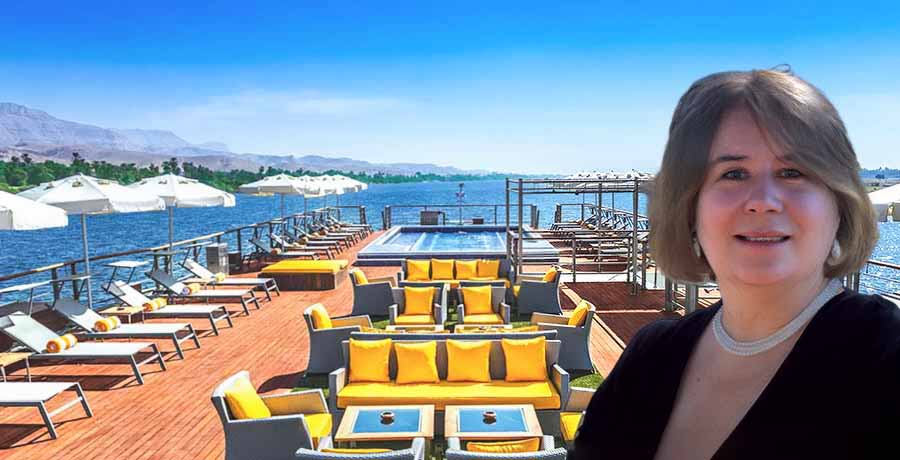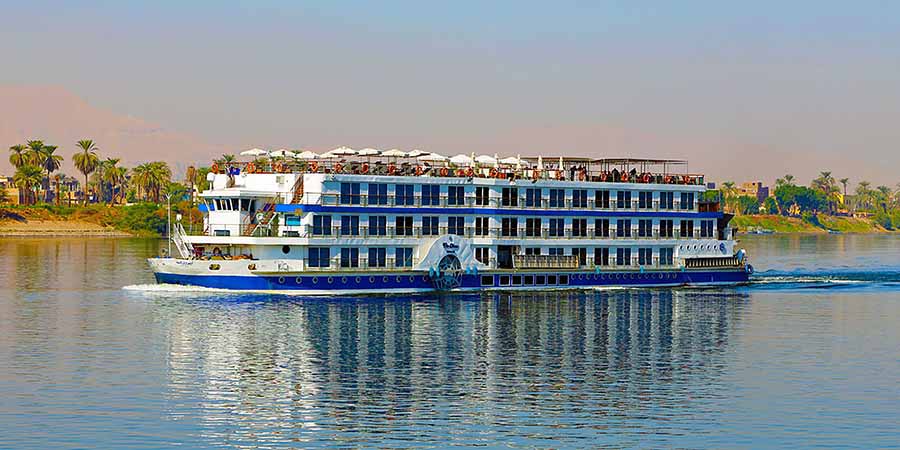
It is impossible not to think of Agatha Christie’s ‘Death on the Nile’ as you board your luxury cruiser at Luxor. But why would you want to? Leaving aside the murders, of course.
It’s one of the strangely satisfying elements of a Nile cruise – how similar the ships, the landscape and the archeological sites look to the many documentaries and dramas you’ve seen on TV and in the cinema.
Experiencing them in real life, of course, is different altogether and ‘drama’ is no exaggeration. There can be little sights more dramatic than those you experience on a Nile cruise. It really delivers what it ‘says on the tin’.
Our cruiser (the ‘Oberoi Philae’, on a four-day/five-star sailing from Luxor to Aswan) was nothing if not luxurious with a large stateroom, floor to ceiling windows, well-equipped bathroom, comfortable beds, quiet but efficient air-conditioning and adequate storage.
And, ladies, if you’ve been searching for an opportunity to wear light, floaty, summer clothing, this is your chance. Floppy hats and comfortable sandals are also de rigueur in the heat of the Egyptian sun.
With a sun-deck and swimming pool on board and a total capacity of 42 passengers, the Oberoi Philae bears little comparison to the cruising behemoths that ply their way around the oceans. With only four decks, there’s no waiting for lifts and no crowding or queueing at any stage.
The restaurant has only one sitting (unlike the behemoths) and it becomes obvious very quickly that the chef on-board takes a real pride in his work – as do the attentive waiters who we found to be genuinely helpful without being intrusive.
When it comes to the ancient sites that you’ve come to see, the Temple of Karnak at Luxor (the city called Thebes in ancient times) is likely to be your first port of call. ‘Massive’ doesn’t begin to describe it. The pillars, courtyards, sphinxes and statues are super-human in size and vision.
The area is still being excavated with a procession-way of hundreds of sphinxes linking Karnak to the Temple of Luxor, about a kilometer away. Watching the sun set over the Nile between the columns of Karnak is an experience you are unlikely ever to forget.
Few people will not already have heard of ‘The Valley of the Kings’ – another site guaranteed not to disappoint. Approaching, it is pretty much bound to remind you of archeology programmes on TV – the sand-coloured rock pierced with horseshoe-shaped holes at the entrances to the various royal tombs.
We grumbled a bit at our early rise on the morning we visited. But – and it’s a huge ‘but’ – it meant that we were on our own and the first to enter the tomb of Tutankhamun. We were alone with King Tut, and not a curse in sight.
What a surprise it was to see his mummy, lying there, right where his body had been left in 1323 BC (although the thousands of treasures found by Howard Carter in 1922 are currently being moved from the old Egyptian Museum at Cairo into the spanking new Grand Egyptian Museum outside the city).
Poor King Tut was born with a club foot (possibly as the result of in-breeding) and died from a leg injury after crashing his chariot, probably around the age of 19. There is a tender portrait of him and his queen on the back of his golden throne (in Cairo) which carries a message of love down the centuries.
There are many other royal tombs to be explored in the same valley. Entering through what appears (at first sight) to be caves, you find yourself in long, well-lit tunnels, richly decorated in paintings of monkeys, snakes and soldiers etc, leading to larger rooms where the expired pharaohs, their bodies mummified, were left for re-birth in the afterlife.
On half-days when you are not sight-seeing, the boat is a relaxing place to sunbathe or swim. Alternatively, you can sit quietly in your cabin watching daily life pass by along the river.
That daily life includes small boys swimming in the water and farmers watering their cattle at the green riverbanks. Two hundred or so yards away from the river, the palm trees, reeds, sugar cane and other crops quickly give way to unforgiving rock and desert.
It reinforces your understanding why the Egyptians worshipped their life-giving river, although its annual floods are now controlled by the High Aswan Dam.
The lives of ancient Egyptians were dominated by the sun and the Nile – although had no explanation for the sun disappearing every evening under the western horizon, only to miraculously reappear every morning in the east. So they created an explanation.
Ra, the sun god, guaranteed the sun’s rebirth every morning by fighting the forces of darkness overnight. Meanwhile, the goddess of the sky gave birth to the night-time moon and stars. Details changed over the millennia but the general thrust remained the same, the triumph of life over darkness.
The tomb wall paintings are so vivid, you have to wonder if they were re-touched in modern times but no – they were created with paints originally made from ground-up precious stones, so many are just as colourful as they were centuries ago.
Further upstream from Luxor lies the Temple of Sobek (the crocodile-headed god of fertility and military might). Actual crocs (and hippos) no longer live in the Nile River, downstream of the Aswan Dam but they very much live upstream in the White and Blue Niles which originate in Lake Victoria and Lake Tana (Ethiopia) respectively.
Temples that were threatened with drowning, when the modern High Aswan Dam began operating, have been painstakingly lifted above the waters and re-built, including the Temple of Isis on the island of Philae in the lower Aswan Reservoir.
The furthest temple upstream (on Lake Nasser) is Abu Simbel, built between 1279 and 1213 BC. Four colossal (65 feet/20 meters high) statues of Ramses II sit in pairs flanking the entrance. Most visitors take a flight there as the dam is a barrier to shipping.
The three Great Pyramids and Sphinx are located at Giza, just outside Cairo (population now about 48 million) and a two-day extension to your cruise, via a 90-minute flight from Aswan, is worth it.
- We booked through Oasis Travel of Holywood, County Down, and travelled with Abercrombie & Kent who arranged all transfers and guides. As English is only rarely spoken, independent travel (while possible) could lead to missing out on experiences and the best guides (who make it all come alive). Our guide was the highly recommended Egyptologist Baher Zaher (bobegy@yahoo.com).
WHAT’S HOT
- The experience of river cruising: relaxing, plenty to watch on the riverbanks (sometimes fertile farms and fields/sometimes rocky mountains and desert), swimming in the ship’s pool to cool off in the (sometimes) 40C heat.
- The archaeological sites: nothing can prepare you for the massive structures of the temples at Karnak, Kom Obo or Philae or the scope of ‘The Valley of the Kings’.
- It’s impossible to take a bad photo of Egyptian monuments but keep your phone in check as you will witness mind-blowing sights around virtually every corner.
- We were not, as some travellers have complained, harassed by street-vendors. We found every single Egyptian we met to be polite, friendly and helpful.
WHAT’S NOT
- The heat can be unbearable in the afternoons. We hit 40C at Aswan in mid-September which makes sight-seeing less enjoyable. Early morning rises are an excellent idea.
- If the partaking of alcohol is a priority for your holiday, be prepared for some eye-watering prices. This is, after all, a Muslim country.
- Although the attractions of being an independent traveller are many, you will be far better off with reliable transfers and experienced guides organised in advance. But remember to budget for tips.




